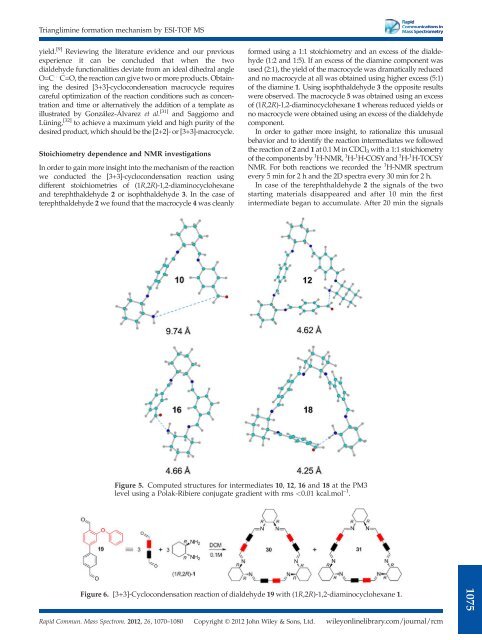The Development of Novel Antibiotics Using ... - Jacobs University
The Development of Novel Antibiotics Using ... - Jacobs University
The Development of Novel Antibiotics Using ... - Jacobs University
You also want an ePaper? Increase the reach of your titles
YUMPU automatically turns print PDFs into web optimized ePapers that Google loves.
Trianglimine formation mechanism by ESI-TOF MS<br />
yield. [9] Reviewing the literature evidence and our previous<br />
experience it can be concluded that when the two<br />
dialdehyde functionalities deviate from an ideal dihedral angle<br />
O=C ... C=O,thereactioncangivetwoormoreproducts.Obtaining<br />
the desired [3+3]-cyclocondensation macrocycle requires<br />
careful optimization <strong>of</strong> the reaction conditions such as concentration<br />
and time or alternatively the addition <strong>of</strong> a template as<br />
illustrated by González-Álvarez et al. [31] andSaggiomoand<br />
Lüning, [32] to achieve a maximum yield and high purity <strong>of</strong> the<br />
desired product, which should be the [2+2]- or [3+3]-macrocycle.<br />
Stoichiometry dependence and NMR investigations<br />
In order to gain more insight into the mechanism <strong>of</strong> the reaction<br />
we conducted the [3+3]-cyclocondensation reaction using<br />
different stoichiometries <strong>of</strong> (1R,2R)-1,2-diaminocyclohexane<br />
and terephthaldehyde 2 or isophthaldehyde 3. In the case <strong>of</strong><br />
terephthaldehyde 2 we found that the macrocycle 4 was cleanly<br />
formed using a 1:1 stoichiometry and an excess <strong>of</strong> the dialdehyde<br />
(1:2 and 1:5). If an excess <strong>of</strong> the diamine component was<br />
used (2:1), the yield <strong>of</strong> the macrocycle was dramatically reduced<br />
and no macrocycle at all was obtained using higher excess (5:1)<br />
<strong>of</strong> the diamine 1. <strong>Using</strong> isophthaldehyde 3 theoppositeresults<br />
were observed. <strong>The</strong> macrocycle 5 was obtained using an excess<br />
<strong>of</strong> (1R,2R)-1,2-diaminocyclohexane 1 whereas reduced yields or<br />
no macrocycle were obtained using an excess <strong>of</strong> the dialdehyde<br />
component.<br />
In order to gather more insight, to rationalize this unusual<br />
behavior and to identify the reaction intermediates we followed<br />
the reaction <strong>of</strong> 2 and 1 at 0.1 M in CDCl 3 with a 1:1 stoichiometry<br />
<strong>of</strong> the components by 1 H-NMR, 1 H- 1 H-COSYand 1 H- 1 H-TOCSY<br />
NMR. For both reactions we recorded the 1 H-NMR spectrum<br />
every 5 min for 2 h and the 2D spectra every 30 min for 2 h.<br />
In case <strong>of</strong> the terephthaldehyde 2 the signals <strong>of</strong> the two<br />
starting materials disappeared and after 10 min the first<br />
intermediate began to accumulate. After 20 min the signals<br />
Figure 5. Computed structures for intermediates 10, 12, 16 and 18 at the PM3<br />
level using a Polak-Ribiere conjugate gradient with rms

















